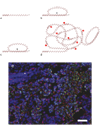Methods for analysis of the cancer microenvironment and their potential for disease prediction, monitoring and personalized treatments
- PMID: 22738217
- PMCID: PMC3384241
- DOI: 10.1007/s13167-012-0140-3
Methods for analysis of the cancer microenvironment and their potential for disease prediction, monitoring and personalized treatments
Abstract
A tumor does not consist of a homogenous population of cancer cells. Therefore, to understand cancer, the tumor microenvironment and the interplay between the different cell types present in the tumor has to be taken into account, and how this regulates the growth and survival of the cancer cells. To achieve a full picture of this complex interplay, analysis of tumor tissue should ideally be performed with cellular resolution, providing activity status of individual cells in this heterogeneous population of different cell-types. In addition, in situ analysis provides information on the architecture of the tissue wherein the cancer cells thrive, providing information of the identity of neighboring cells that can be used to understand cell-cell communication. Herein we describe how padlock probes and in situ PLA can be used for visualization of nucleic acids and protein activity, respectively, directly in tissue sections, and their potential future role in personalized medicine.
Figures


References
LinkOut - more resources
Full Text Sources

